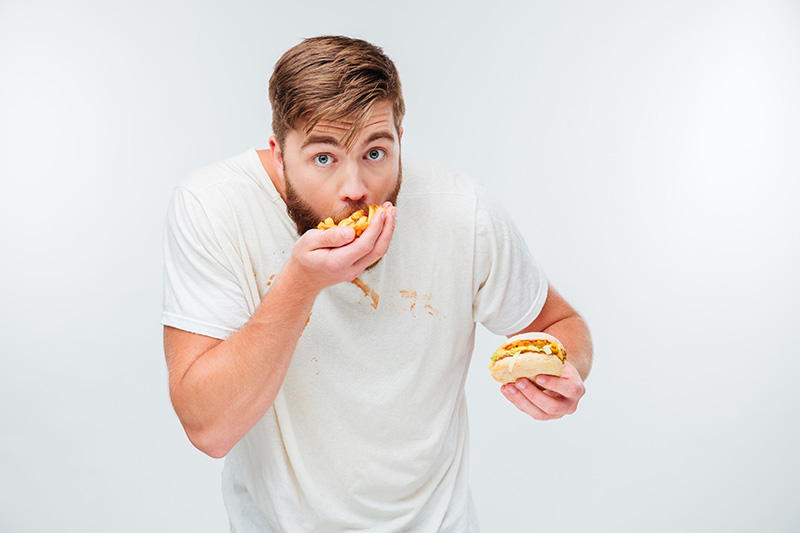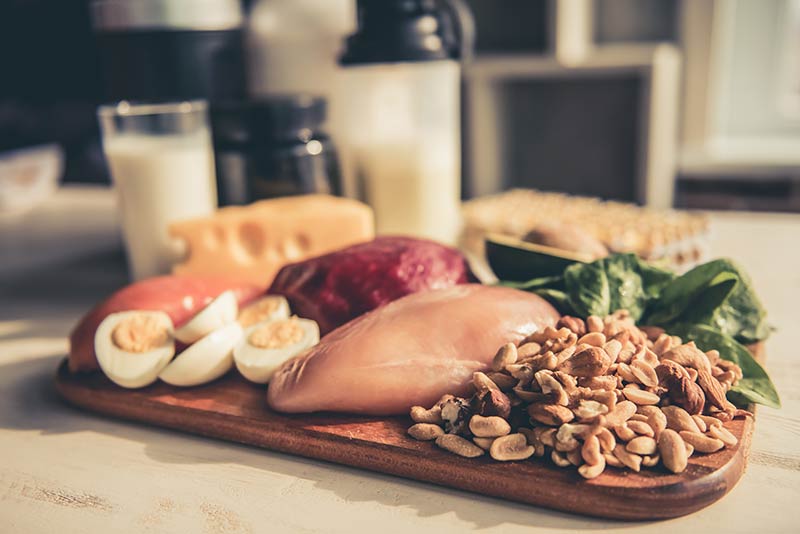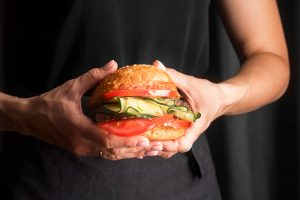When you’re trying to cut weight, a sudden switch to a healthier lifestyle can be difficult to adapt to. Especially when we start talking about reducing portion sizes and consuming fewer calories.
Let’s be honest, they’re hard to keep to. And when you’re following your new plan perfectly and not seeing results, or not seeing a noticeable difference as quickly as you’d like, it can be incredibly frustrating. So what do you do?
Well, this is where a refeed meal comes into play. But what are refeed days?
Put simply, a refeed meal or ‘refeed days’ is a planned increase in calories, either for one meal only, or for one entire day. Many opt for these refeed days either once a week, or every other week, giving their body a break from calorie restrictions.
When you’ve been following a strict nutrition plan long-term, it’s not uncommon to start dreaming about baked goods. Just the sound of a packet rustling can make you want to gear yourself up for a refeed meal.
Guys, I get it. But in order to get the most out of your healthy diet (and of course your refeed meal), we’re going to tell you how to do it properly.
Why do we crave food so much?

The more stringent you are with your diet, especially while working towards a low body fat percentage, the more that certain food cravings become a real challenge.
Having these types of cravings doesn’t necessarily mean that your diet plan is unhealthy or unsustainable, but simply a result of your body’s main driver – survival. When you are not receiving enough energy to sustain your current size, various feedback loops are in place to disrupt your new lifestyle pattern.
When you’re feeling true hunger alongside those deep stomach growls, this is your brain nudging you towards filling fuel reserves (fat cells) which are being quickly depleted. As you continue along this path, reducing body fat long-term, your body finds its way to respond, by “upregulating” (increasing) leptin levels.
While you may feel fine in yourself eating less, leptin signals your body to consume more, increasing hunger and making it very tempting to snack on everything in sight.
So what is a refeed day? And why do people do them?
Popular safe and legal steroid alternatives
What is a refeed day?

Instead of dreaming yourself silly over the idea of demolishing a box of cookies, a refeed diet day can be crucial for keeping you on track. During this period (whether you opt for refeed days, or a single refeed meal), you’ll allow yourself to intentionally overconsume calories.
Sure, you’ll be heading out of your calorie deficit, but the food you choose does still matter. The trouble is, during a calorie deficit, your hormone levels can decrease, while your hunger goes up.
But that’s not all, since it’s not uncommon to feel lethargic and tired, you run the risk of potentially hitting a weight loss plateau.
But surely a refeed meal is just a cheat meal, no? Well, not quite.
Cheat day vs cheat meal (or refeed meal)

In order to maximize your gym time and keep to your healthy lifestyle, it’s important to understand the difference between a cheat meal and a refeed meal.
While it may sound like the two are identical, there’s actually a considerable difference between them. Let’s take a closer look at a cheat day vs cheat meal.
Many of us hit a point where we begin to crave the foods we’re not allowing ourselves to have. Whether it’s sugary candy or even a soda or two, when we find ourselves focusing on the food we can’t eat, it can make healthy eating 10x harder.
Also Read: Food swaps to cut the calories
When we talk about cheat meals, the name alone sounds like you’re doing something naughty. And that’s because you are. During a cheat meal, or cheat day, we’re usually pretty relaxed about what we decide to eat, paying no real attention to macros or our calorie intake.
Think of cheat meals (most of the time) like a no holds barred day off from your diet plan.
Refeed days and refeed meals, however, is a deliberate overeating opportunity. Unlike a cheat meal (or even a dirty bulk), a refeed diet consisting of overeating a specific macro – in the form of carbs. So. no, that doesn’t mean you can go order take out and scoff donuts.
Of course, when comparing cheat day vs cheat meal (in the form of a refeed meal), both are designed to help deal with cravings and curb those urges to fall off the wagon. But like we previously mentioned, refeed days and meals aren’t about eating everything in sight, but carefully eating more of the right macronutrient: carbohydrates.
In short: Cheat days are uncontrolled and unplanned days of eating. With whatever you like in unlimited quantity.
A cheat meal (refeed meal): Is carefully planned and controlled. With only a slight increase in calories, a refeed diet prioritizes carbs over protein and fat.
What is a refeed day, then? Why do it?

When you’re trying to lose weight and eat well, surely it doesn’t make sense to have occasional refeed days? Actually, it does. Allow me to explain.
While going on a total binge-fest wouldn’t do your goals any good, a temporary calorie surplus can help to kick your weight loss once again. This is because when you’ve been in a calorie deficit for some time, your weight loss can quickly slow down or totally plateau.
As you lower your calorie intake and head into a calorie deficit, while losing fat, your hormones also begin to change. When this occurs, your body will naturally look for ways to limit weight loss – this is when the hormone leptin starts to decline.
Produced by fat cells, leptin tells your body that it has adequate fat stores, encouraging calorie burn and helping to regulate your appetite. When this hormone gets low, a signal reaches the brain, telling it that you’re entering an unknown period of calorie deprivation. As a result of this, your body is then signalled to eat more, burning fewer calories – otherwise known as adaptive thermogenesis.
Adaptive thermogenesis explained
When you continue on your long-term path to reducing your body fat percentage, adaptive thermogenesis can set in, signalling your body to eat more and burn less. This protective process alters your metabolism, to increase energy intake and decrease energy output to slow weight loss.
During this, food cravings increase, since your body releases various hormones. But there’s more… The rate at which you burn calories can also alter. For example, you may experience a decrease in exercise activity thermogenesis (EAT) and non-exercise activity thermogenesis (NEAT).
A refeed meal: The way to win?

One of the biggest struggles during a cut – or long term strategy – is controlling those hunger pangs as you push for low body fat levels. The trouble is, we’re only human, am I right? And when you significantly decrease your intake, it’s going to shock your body into wanting to hold onto what it has, as we mentioned above.
However, there are plenty of ways to manage your hunger day to day, however, long term, can require some different type of tricks in the form of refeed days.
Also Read: Perfect cheat meals while cutting
By allowing yourself to occasionally have some of the foods you crave can help to increase fullness, by encouraging fat cells to release more leptin. This is exactly how a refeed meal or refeed days work. By incorporating a refeed meal carefully into your schedule, you consume significantly more energy (kcals) than is normal for your body, causing your leptin levels to decrease and suppress your appetite.
In turn, this sudden change will help to reduce those cravings for baked goods and cookies. If you’re struggling to stay on track long term, or feel as though your weight loss has halted, refeed days can be your secret weapon.
Popular safe and legal steroid alternatives
What are the benefits of refeed days?
There are several potential benefits to sneaking a refeed meal into your schedule every once and a while.
May prevent a plateau in weight loss
When we first set out to lose weight, those initial few weeks can fill us with motivation and enthusiasm to keep going.
However, these results can soon trail off, leaving us confused about what to do next. This is usually due to the survival process our body gets into, aka, adaptive thermogenesis.
Incorporating refeed days can help to prevent a plateau in your weight loss by temporarily increasing your calorie intake carefully.
May help prevent binge eating

When you’ve planned out a refeed meal, you’re far less likely to start eating everything in the fridge. Unlike a cheat meal, a refeed meal means still be careful about what you’re eating, upping your carbs selectively.
Since it becomes easy to start craving all the sugary foods under the sun, adding refeed days into your schedule occasionally can help to reignite your weight loss results and prevent you from going on a total food binge.
Are there any downsides to refeed days?
Where there seem to be plenty of pros in line with a refeed meal or two, are there any cons to refeed days?
- More research needed – While the idea of refeed days makes sense, many researchers still argue the topic of adaptive thermogenesis, bringing their true benefit into consideration
- Easy to get carried away – This one may depend on your self control, however, when you allow yourself to have a refeed meal, it can be tempting (of course!) to go overboard with your refeed diet
- It’s still a ‘diet’ mentality – Adding refeed days encourage a temporary respite from calorie restriction, however, they still emphasize diets as a way to lose weight.
What does a refeed meal look like?
If you’re still keen on adding refeed days into your regime, here’s how to set one up. Planning is crucial to ensure you don’t go overboard.
Also Read: Cutting: How to create a calorie deficit for weight loss
Generally speaking, many guys on this type of long term strategy opt for refeed days every two weeks, however, this can be adjusted according to your goals and body fat %.
To make things a little easier, use the following chart:
| Body fat percentage % | Days of refeeding |
| Men: 10% or more | Once every 2 weeks |
| Women: 20% or more | Once every 2 weeks |
| Men: 10% or less | 1–2 times per week |
| Women: 15–20%* | 1–2 times per week |
*Most women should aim to have a body fat percentage of 15% plus to support reproductive and overall health.
Here’s an example refeed day:
- Breakfast: 3–4 whole wheat pancakes with walnuts and maple syrup, with one scoop of whey protein powder (or plant-based protein powder)
- Snack: 1 cup (225 grams) of cottage cheese with raspberries
- Lunch: Turkey sandwich on whole-grain bread with tomatoes, lettuce, mayonnaise, and mozzarella cheese
- Snack: Shake made with either dairy or plant-based milk, bananas, berries, hemp seeds, and whey protein powder
- Dinner: 5–6 ounces (140–170 grams) of chicken breast, 1–2 cups (195–390 grams) of brown rice, 1–2 cups (175–350 grams) of sautéed vegetables
- Dessert: 1/2 cup (130 grams) of chocolate pudding
Conclusion

While refeed days are designed to give your body (and sanity!) a break from a strict calorie deficit, this temporary break also has the potential to build an unhealthy relationship with food.
Refeed days aim to improve your leptin levels, curbing weight loss plateaus and keeping you on track with your body fat goals. With the potential to lower your risk of binging, there are multiple benefits you can enjoy during a refeed day.
However, with some researchers still out on their verdict on refeed days, it’s totally up to you if you opt for this strategy to continue your weight loss efforts.
I get it guys, we all get hungry, especially during a cutting phase. This is why we created our 100% natural and safe cutting products, so you can cut through fat, keep lean muscle and build strength – all with zero side effects and not a needle in sight.
















